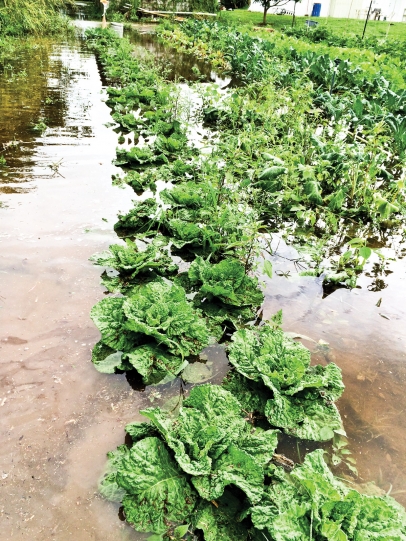When Nature Gets in the Way
Most of South Florida’s tropical conditions (intense rain, heat and humidity) occur in summer and our temperate conditions (less rain, cooler weather and less humidity) happen in winter. But sometimes weather can be unpredictable and bring surprises.
This last fall, we experienced warmer temperatures and a lot more rain than usual. The almost continuous rain in the first week of December caused significant flooding and overly wet conditions in local farms and gardens. “The average rainfall for the entire month of December is 2.05 inches,” says Tiffany Noe, who runs Little River Cooperative with Muriel Olivares. “We got more than 6 inches in one night on Dec. 3.” At their farm, among many that got caught by flooding, many crops were underwater and essentially drowned. “When something like this happens you’ve got to make some tough decisions,” says farmer Chris French. “Pull out the battered, sick or stalled plants and plant anew. Space and time is often valuable in the garden, and tough love is often necessary.”
What You Can Do
To prepare for extreme rainfall, you can take some steps when planting your garden to mitigate the damage:
- Plant crops that require extra drainage in higher elevations and/or raised garden beds or mounds.
- Amend soil to increase drainage. Most soil in South Florida is sandy and rocky and drains well naturally. But sometimes soil doesn’t drain particularly well. Add sand, perlite and vermiculite to help increase the soil’s porosity.
- Plant a wide variety of crops, including those originating in tropical climates that can withstand excessive rain, heat and humidity.
- Plant in locations with full sun and good air circulation, the most important factors for a successful garden, regardless of weather. The more light, the better most plants grow. With increased rain and humidity, it’s even more critical – the sun helps plants use the moisture in the soil and helps the water evaporate from both the soil and foliage. Gardens in shadier areas often will not dry out quickly enough and become adversely affected by bacteria and fungus.
- If you use sprinklers or drip irrigation systems for watering gardens, micromanage them. Many gardeners with irrigation systems leave them on when there’s a lot of rain. Turn them off to give the gardens a day or two without irrigation after it stops raining to allow the soil to dry out. Reduce the duration and frequency of irrigation on the timer and increase the duration and frequency in periods of hot, dry weather.
- Most plants require less frequent irrigation and plants become larger and root systems are more established. Many plants prefer drip irrigation that delivers water directly to the soil via driplines instead of overhead irrigation that makes leaves wet and can promote bacteria and fungus.
- Take extra care to manage increased pest issues caused by warm, rainy weather. Cooler weather usually reduces the presence of many pests in the garden. When it’s warm, you’ll need to work more to keep them under control.
- Start delicate crops in small pots or seedling trays in areas that are protected from rain. When they’re larger, plant them in the garden so they have a better chance of tolerating weather variability.
Some Like It Hot
We typically plant the same crops as usual for the season, but there may be a lack of vigor in crops that like it cold, and increased vigor for plants that like it warm. South Florida can also experience temperatures that drop close to or below freezing. When this happens, water more than usual to retain heat in the soil and plants. You can also cover plants with sheets or a special agricultural fabric such as Agribon.
Global warming plays a role in making South Florida’s winters warmer, wetter and less predictable. Sea-level rise affects our soil’s ability to absorb water and leads to increased flooding. Miami Beach’s recurrent flooding got national attention in Elizabeth Kolbert’s article, “The Siege of Miami,” which appeared Dec. 21, 2015, in The New Yorker. She writes: “For the past several years, the daily high-water mark in the Miami area has been racing up at the rate of almost an inch a year, nearly ten times the rate of average global sea-level rise. It’s unclear exactly why this is happening, but it’s been speculated that it has to do with changes in ocean currents which are causing water to pile up along the coast. Talking about climate change in the Everglades on Earth Day, President Obama said, ‘Nowhere is it going to have a bigger impact than here in South Florida.’” She adds: “Researchers at Florida Atlantic University have found that with just six more inches of sea-level rise the district will lose almost half its flood-control capacity.”
The topic of climate change invites differences of opinion. But one thing we can agree on is that it’s hard to predict the weather. Farming and gardening here require a willingness to face challenges and tackle them in order to continue to grow food.
Have an edible gardening question? Email Dylan.





